Determining the Spectral Requirements for Cyanobacteria Detection for the CyanoSat Hyperspectral Imager with Machine Learning
Abstract
:1. Introduction
- Determine the relative importance of each of the instrument’s spectral channels for quantitative cyanobacteria detection with a view to prioritizing bands for download or grouping.
- Assess the performance of the CyanoSat and various minimal spectral configurations for determining the concentration of pigments Chl-a, PC, and cyanobacteria composition.
- Assess parameter retrieval performance with top-of-atmosphere (TOA) data types that avoid the need for error-prone atmospheric correction of CyanoSat data.
- Assess whether there is any advantage to a narrower FWHM of 8 nm compared to the nominal 12 nm FWHM CyanoSat configuration.
2. Materials and Methods
2.1. Description of the CyanoSat Imager
2.2. Synthetic Dataset
2.3. Parameter Retrieval Using Machine Learning
2.4. Feature Attributions Scores
| Algorithm 1 |
|
3. Results
3.1. Band Configurations Based on Feature Attributions
3.1.1. Band Positions for Rrs
3.1.2. Band Positions for TOAR and BRR
3.2. Product Retrieval for Band Configurations
3.3. Assessment of 8 nm FWHM on Product Retrieval
3.4. Minimum Viable Spectral Configuration
- The “green peak” near 540 to 560 nm.
- The PC absorption and fluorescence-related features between 610 and 660 nm.
- The Chl-a absorption and fluorescence-related features near 670 to 690 nm.
- The particulate scattering peak between 700 and 730 nm.
4. Discussion
4.1. Spectral Configuration for Cyanobacteria Discrimination
- A spectral configuration with a reduced number of optimally positioned bands can be used for pigment retrieval and cyanobacteria discrimination with ML. This will help to reduce data requirements for download.
- Algorithms can be applied with TOA data types to avoid errors associated with atmospheric correction.
- The 12 nm FWHM band configuration is sufficient since there is no or little advantage in using the narrower 8 nm FWHM configuration.
- As the analysis was performed with every third of CyanoSat’s 300 spectral bands, adjacent bands can be grouped to increase the SNR three-fold without compromising spectral sharpness or product retrieval performance.
- The methodology employed here could be replicated to prioritize spectral regions for sampling for a broad range of applications.
4.2. Limitations
Author Contributions
Funding
Institutional Review Board Statement
Informed Consent Statement
Data Availability Statement
Acknowledgments
Conflicts of Interest
Appendix A
| Band No. | TOA | BRR | Rrs |
|---|---|---|---|
| 1 | 506 | 512 | 536 |
| 2 | 530 | 548 | 548 |
| 3 | 548 | 560 | 560 |
| 4 | 566 | 572 | 578 |
| 5 | 572 | 590 | 590 |
| 6 | 608 | 596 | 599 |
| 7 | 614 | 614 | 614 |
| 8 | 632 | 632 | 623 |
| 9 | 650 | 638 | 626 |
| 10 | 656 | 644 | 632 |
| 11 | 662 | 656 | 674 |
| 12 | 674 | 674 | 680 |
| 13 | 686 | 680 | 695 |
| 14 | 698 | 686 | 698 |
| 15 | 710 | 698 | 704 |
| 16 | 722 | 716 | 722 |
| 17 | 740 | 722 | 728 |
| 18 | 752 | 746 | 740 |
| 19 | 758 | 764 | 746 |
| 20 | 764 | 770 | 749 |
| 21 | 770 | 782 | 758 |
| 22 | 782 | 761 | |
| 23 | 788 | 764 | |
| 24 | 776 |
References
- Carmichael, W.W.; Boyer, G.L. Health impacts from cyanobacteria harmful algae blooms: Implications for the North American Great Lakes. Harmful Algae 2016, 54, 194–212. [Google Scholar] [CrossRef] [PubMed]
- Falconer, I.R. Toxic cyanobacterial bloom problems in Australian waters: Risks and impacts on human health. Phycologia 2001, 40, 228–233. [Google Scholar] [CrossRef]
- Preece, E.P.; Hardy, F.J.; Moore, B.C.; Bryan, M. A review of microcystin detections in Estuarine and Marine waters: Environmental implications and human health risk. Harmful Algae 2017, 61, 31–45. [Google Scholar] [CrossRef]
- Chorus, I.; Falconer, I.R.; Salas, H.J.; Bartram, J. Health risks caused by freshwater cyanobacteria in recreational waters. J. Toxicol. Environ. Health Part B Crit. Rev. 2000, 3, 323–347. [Google Scholar]
- Hunter, P.D.; Tyler, A.N.; Gilvear, D.J.; Willby, N.J. Using remote sensing to aid the assessment of human health risks from blooms of potentially toxic cyanobacteria. Environ. Sci. Technol. 2009, 43, 2627–2633. [Google Scholar] [CrossRef]
- Kutser, T.; Metsamaa, L.; Strömbeck, N.; Vahtmäe, E. Monitoring cyanobacterial blooms by satellite remote sensing. Estuar. Coast. Shelf Sci. 2006, 67, 303–312. [Google Scholar] [CrossRef]
- Wynne, T.T.; Stumpf, R.P.; Tomlinson, M.C.; Dyble, J. Characterizing a cyanobacterial bloom in western Lake Erie using satellite imagery and meteorological data. Limnol. Oceanogr. 2010, 55, 2025–2036. [Google Scholar] [CrossRef]
- Matthews, M.W.; Bernard, S.; Robertson, L. An algorithm for detecting trophic status (chlorophyll-a), cyanobacterial-dominance, surface scums and floating vegetation in inland and coastal waters. Remote Sens. Environ. 2012, 124, 637–652. [Google Scholar] [CrossRef]
- Ogashawara, I. Determination of phycocyanin from space—A Bibliometric analysis. Remote Sens. 2020, 12, 567. [Google Scholar] [CrossRef]
- Stumpf, R.P.; Davis, T.W.; Wynne, T.T.; Graham, J.L.; Loftin, K.A.; Johengen, T.H.; Gossiaux, D.; Palladino, D.; Burtner, A. Challenges for mapping cyanotoxin patterns from remote sensing of cyanobacteria. Harmful Algae 2016, 54, 160–173. [Google Scholar] [CrossRef]
- Li, L.; Li, L.; Song, K. Remote sensing of freshwater cyanobacteria: An extended IOP Inversion Model of Inland Waters (IIMIW) for partitioning absorption coefficient and estimating phycocyanin. Remote Sens. Environ. 2015, 157, 9–23. [Google Scholar] [CrossRef]
- Kravitz, J.; Matthews, M.; Lain, L.; Fawcett, S.; Bernard, S. Potential for high fidelity global mapping of common inland water quality products at high spatial and temporal resolutions based on a synthetic data and machine learning approach. Front. Environ. Sci. 2021, 9, 587660. [Google Scholar] [CrossRef]
- Zolfaghari, K.; Pahlevan, N.; Binding, C.; Gurlin, D.; Simis, S.G.; Verdú, A.R.; Li, L.; Crawford, C.J.; VanderWoude, A.; Errera, R.; et al. Impact of spectral resolution on quantifying cyanobacteria in lakes and reservoirs: A machine-learning assessment. IEEE Transact. Geosci. Remote Sens. 2021, 60, 1–20. [Google Scholar] [CrossRef]
- Metsamaa, L.; Kutser, T.; Strömbeck, N. Recognising cyanobacterial blooms based on their optical signature: A modelling study. Boreal Env. Res. 2006, 11, 493–506. [Google Scholar]
- Kravitz, J.; Matthews, M.; Bernard, S.; Griffith, D. Application of Sentinel 3 OLCI for chl-a retrieval over small inland water targets: Successes and challenges. Remote Sens. Environ. 2020, 237, 111562. [Google Scholar] [CrossRef]
- Spyrakos, E.; O’donnell, R.; Hunter, P.D.; Miller, C.; Scott, M.; Simis, S.G.; Neil, C.; Barbosa, C.C.; Binding, C.E.; Bradt, S.; et al. Optical types of inland and coastal waters. Limnol. Oceanogr. 2018, 63, 846–870. [Google Scholar] [CrossRef]
- Ramsay, J.O.; Silverman, B.W. Principal components analysis for functional data. In Functional data analysis; Springer: New York, NY, USA, 2005; pp. 147–172. [Google Scholar]
- Matthews, M.W.; Bernard, S.; Evers-King, H.; Lain, L.R. Distinguishing cyanobacteria from algae in optically complex inland waters using a hyperspectral radiative transfer inversion algorithm. Remote Sens. Environ. 2020, 248, 111981. [Google Scholar] [CrossRef]
- Yacobi, Y.Z.; Köhler, J.; Leunert, F.; Gitelson, A. Phycocyanin-specific absorption coefficient: Eliminating the effect of chlorophylls absorption. Limnol. Oceanogr. Methods 2015, 13, 157–168. [Google Scholar] [CrossRef]
- Aerosol Robotic Network (AERONET). Available online: https://aeronet.gsfc.nasa.gov (accessed on 21 June 2023).
- Ivanovs, M.; Kadikis, R.; Ozols, K. Perturbation-based methods for explaining deep neural networks: A survey. Pattern Recognit. Lett. 2021, 150, 228–234. [Google Scholar] [CrossRef]
- Fisher, A.; Rudin, C.; Dominici, F. All Models are Wrong, but Many are Useful: Learning a Variable's Importance by Studying an Entire Class of Prediction Models Simultaneously. J. Mach. Learn. Res. 2019, 20, 1–81. [Google Scholar]
- Ryan, J.P.; Davis, C.O.; Tufillaro, N.B.; Kudela, R.M.; Gao, B.C. Application of the hyperspectral imager for the coastal ocean to phytoplankton ecology studies in Monterey Bay, CA, USA. Remote Sens. 2014, 6, 1007–1025. [Google Scholar] [CrossRef]
- Matthews, M.W.; Bernard, S. Using a two-layered sphere model to investigate the impact of gas vacuoles on the inherent optical properties of Microcystis aeruginosa. Biogeosciences 2013, 10, 8139–8157. [Google Scholar] [CrossRef]
- Matsushita, B.; Yang, W.; Yu, G.; Oyama, Y.; Yoshimura, K.; Fukushima, T. A hybrid algorithm for estimating the chlorophyll-a concentration across different trophic states in Asian inland waters. J. Photogramm. Remote Sens. 2015, 102, 28–37. [Google Scholar] [CrossRef]
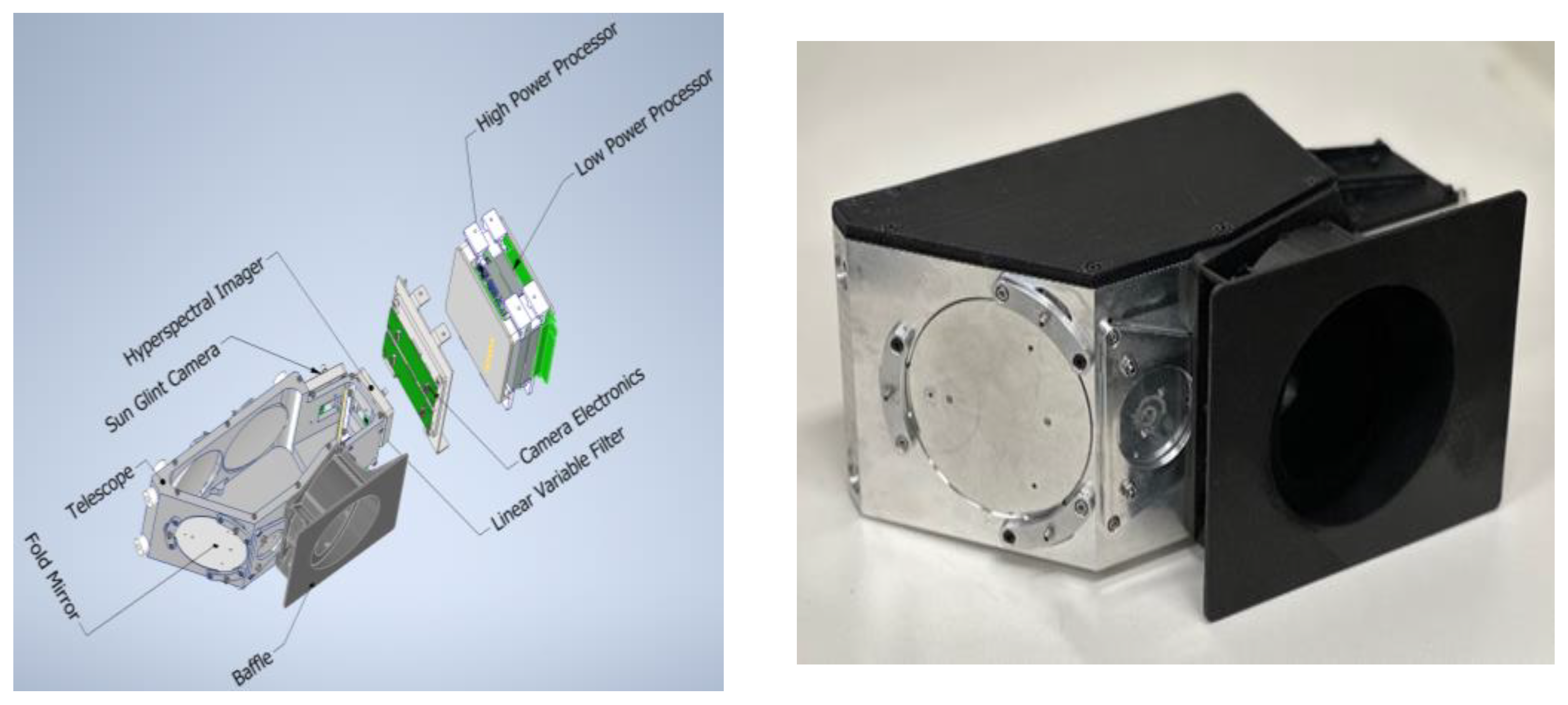
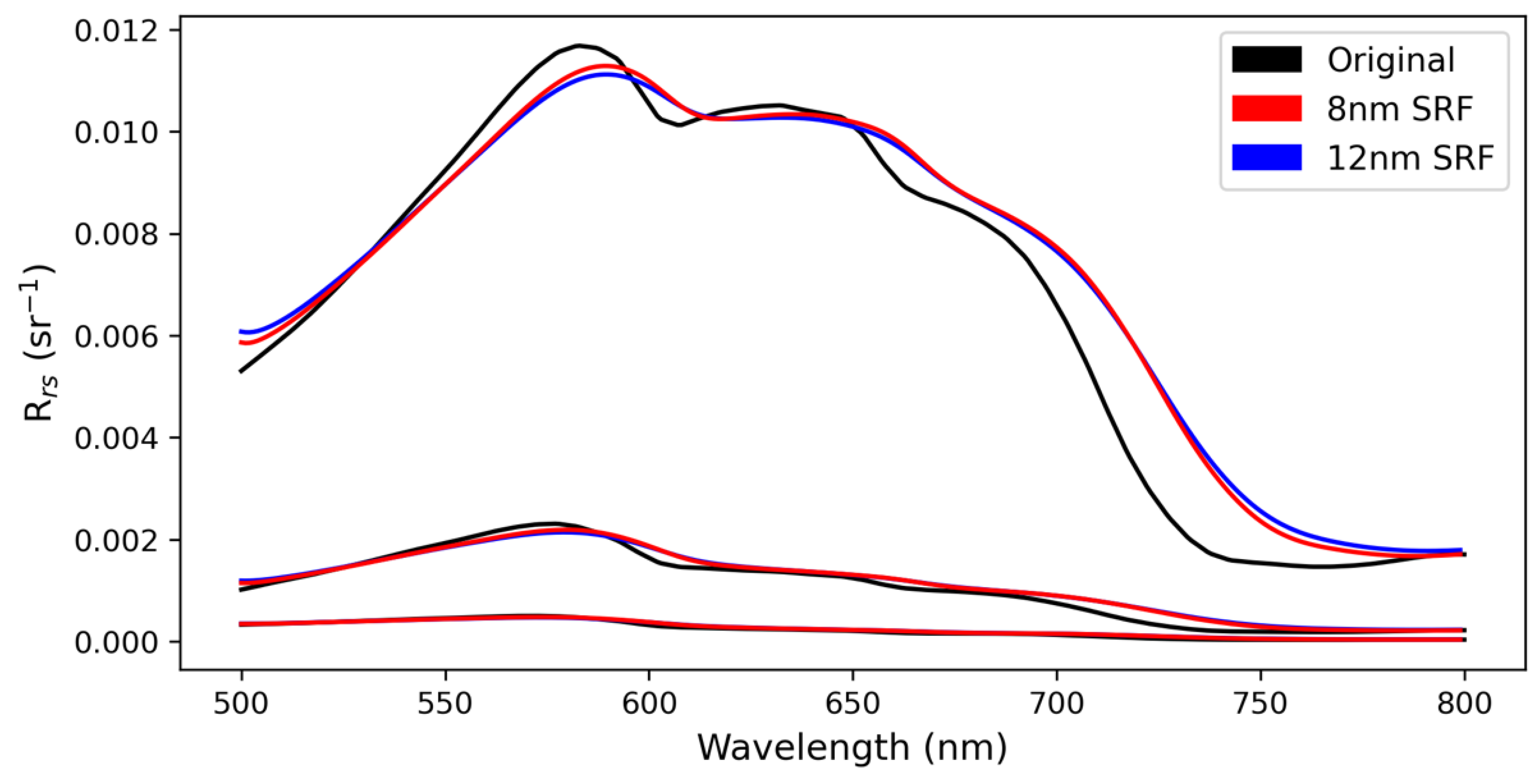
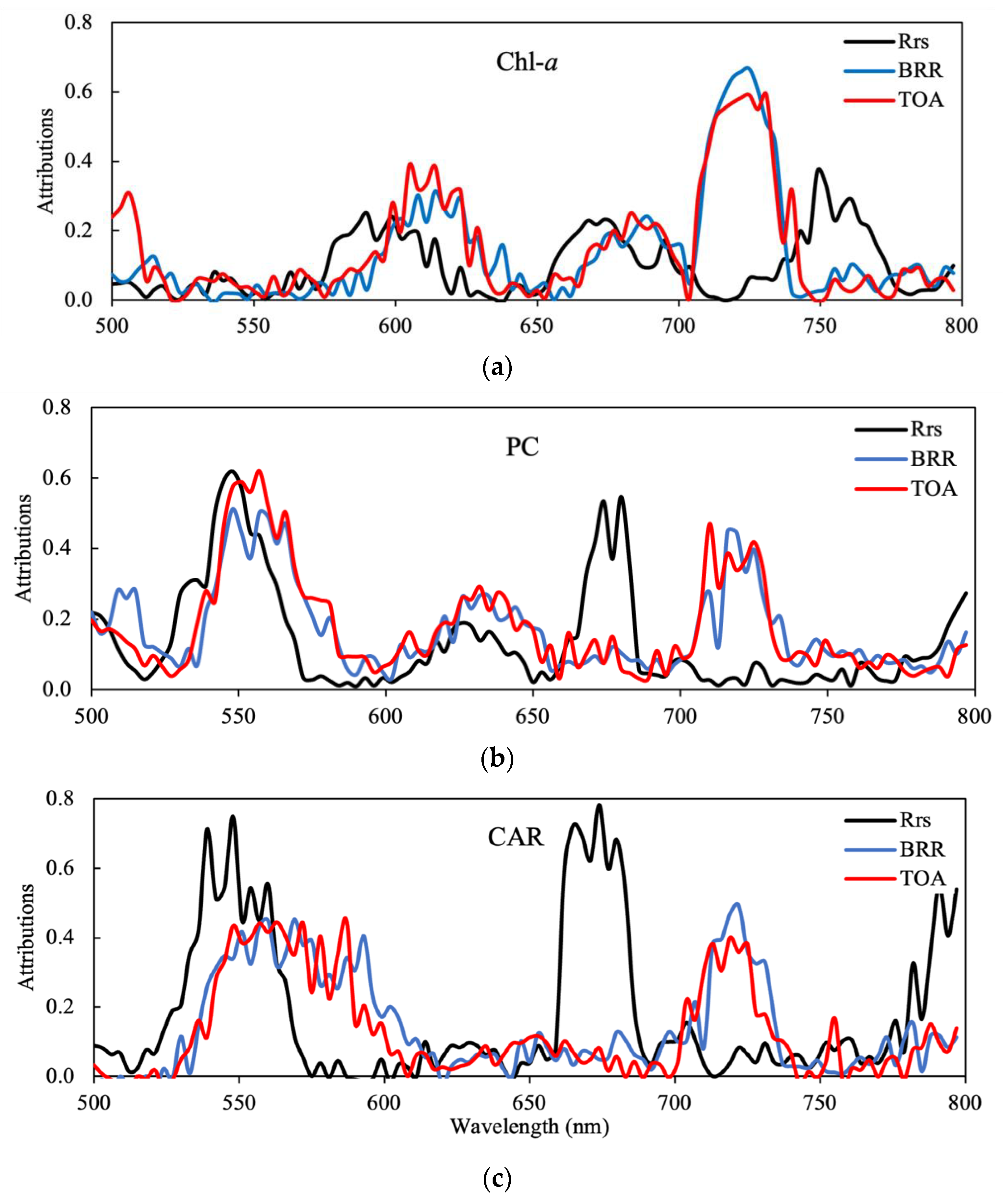
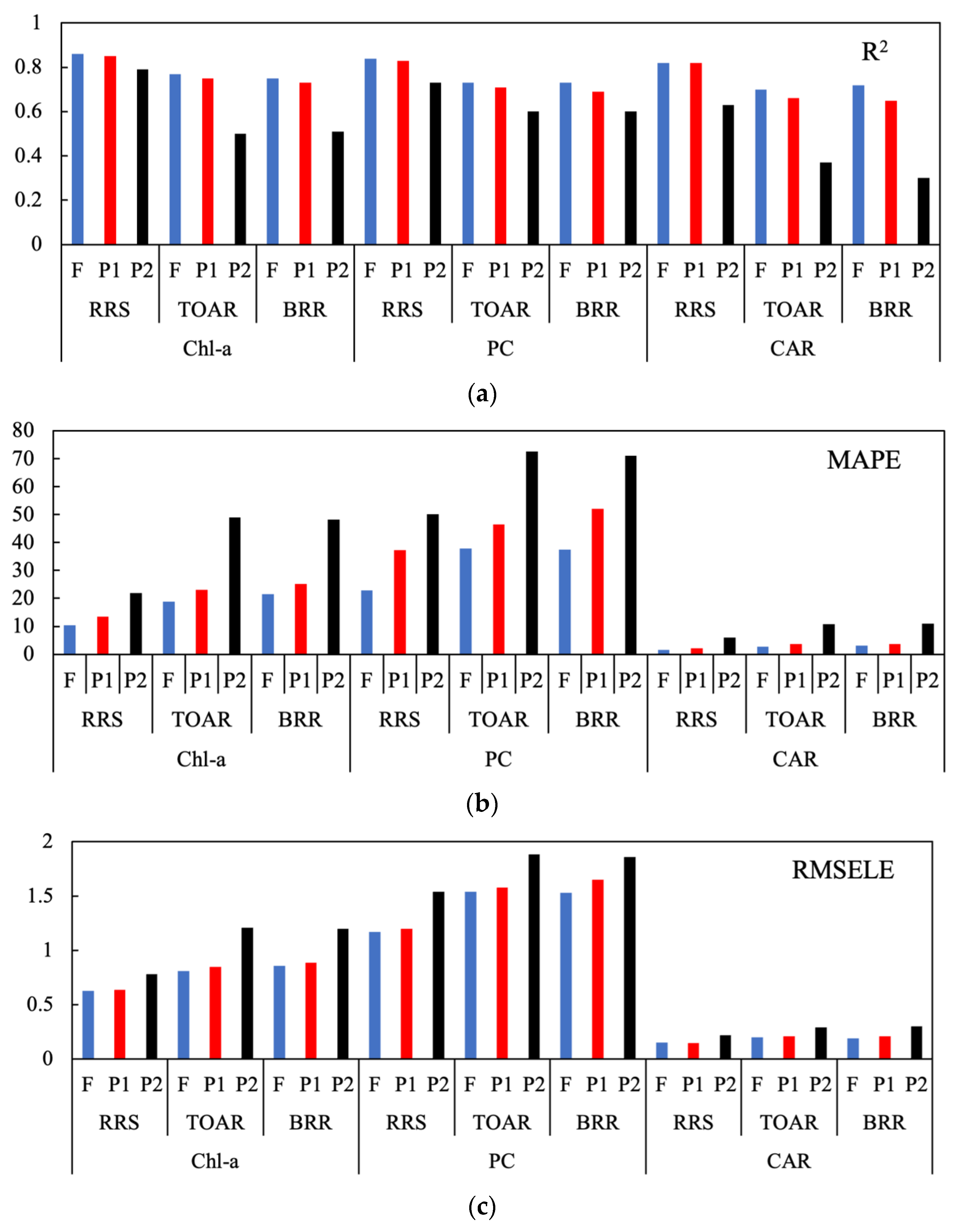
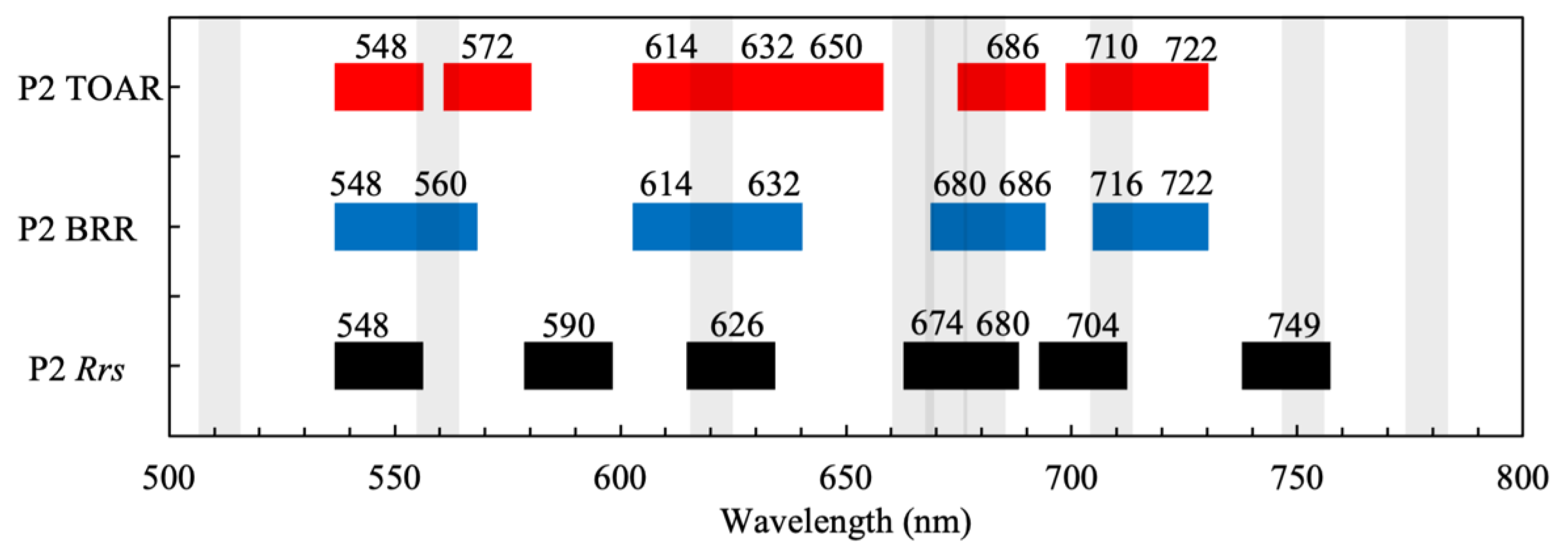
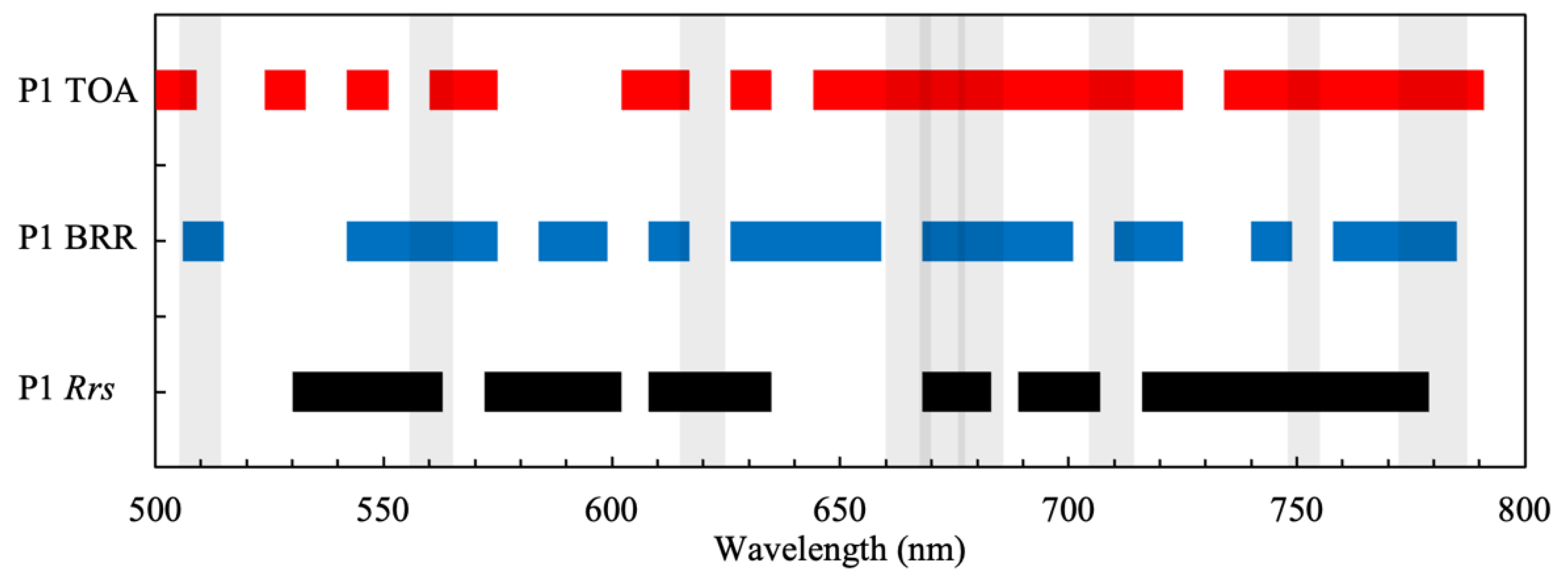
| Chl-a | PC | CAR | |||||||
|---|---|---|---|---|---|---|---|---|---|
| Rrs | TOAR | BRR | Rrs | TOAR | BRR | Rrs | TOAR | BRR | |
| P2 | 590 | 614 | 614 | 548 | 548 | 548 | 548 | 572 | 560 |
| 674 | 686 | 686 | 626 | 632 | 632 | 674 | 650 | 680 | |
| 749 | 722 | 722 | 680 | 710 | 716 | 704 | 722 | 722 | |
| P1 | 536 | 506 | 512 | 548 | 548 | 512 | 548 | 548 | 560 |
| 590 | 530 | 572 | 578 | 608 | 548 | 560 | 572 | 590 | |
| 599 | 566 | 614 | 626 | 632 | 560 | 614 | 614 | 638 | |
| 614 | 614 | 638 | 680 | 662 | 596 | 632 | 632 | 656 | |
| 623 | 656 | 674 | 698 | 698 | 632 | 674 | 650 | 680 | |
| 674 | 686 | 686 | 728 | 710 | 644 | 704 | 674 | 698 | |
| 695 | 722 | 722 | 746 | 740 | 680 | 722 | 722 | 722 | |
| 749 | 764 | 764 | 764 | 758 | 716 | 740 | 752 | 770 | |
| 761 | 782 | 782 | 776 | 770 | 746 | 758 | 788 | 782 | |
| Product | FWHM | R2 | MAPE | RMSELE |
|---|---|---|---|---|
| Chl-a | 12 | 0.86 | 10.3 | 0.63 |
| 8 | 0.85 | 9 | 0.66 | |
| PC | 12 | 0.84 | 22.9 | 1.17 |
| 8 | 0.85 | 19.5 | 1.14 | |
| CAR | 12 | 0.82 | 1.57 | 0.15 |
| 8 | 0.82 | 1.72 | 0.15 |
| Band No. | TOAR | BRR | Rrs |
|---|---|---|---|
| 1 | 548 | 548 | 548 |
| 2 | 572 | 560 | 590 |
| 3 | 614 | 614 | 626 |
| 4 | 632 | 632 | 674 |
| 5 | 650 | 680 | 680 |
| 6 | 686 | 686 | 704 |
| 7 | 710 | 716 | 749 |
| 8 | 722 | 722 |
Disclaimer/Publisher’s Note: The statements, opinions and data contained in all publications are solely those of the individual author(s) and contributor(s) and not of MDPI and/or the editor(s). MDPI and/or the editor(s) disclaim responsibility for any injury to people or property resulting from any ideas, methods, instructions or products referred to in the content. |
© 2023 by the authors. Licensee MDPI, Basel, Switzerland. This article is an open access article distributed under the terms and conditions of the Creative Commons Attribution (CC BY) license (https://creativecommons.org/licenses/by/4.0/).
Share and Cite
Matthews, M.W.; Kravitz, J.; Pease, J.; Gensemer, S. Determining the Spectral Requirements for Cyanobacteria Detection for the CyanoSat Hyperspectral Imager with Machine Learning. Sensors 2023, 23, 7800. https://doi.org/10.3390/s23187800
Matthews MW, Kravitz J, Pease J, Gensemer S. Determining the Spectral Requirements for Cyanobacteria Detection for the CyanoSat Hyperspectral Imager with Machine Learning. Sensors. 2023; 23(18):7800. https://doi.org/10.3390/s23187800
Chicago/Turabian StyleMatthews, Mark W., Jeremy Kravitz, Joshua Pease, and Stephen Gensemer. 2023. "Determining the Spectral Requirements for Cyanobacteria Detection for the CyanoSat Hyperspectral Imager with Machine Learning" Sensors 23, no. 18: 7800. https://doi.org/10.3390/s23187800
APA StyleMatthews, M. W., Kravitz, J., Pease, J., & Gensemer, S. (2023). Determining the Spectral Requirements for Cyanobacteria Detection for the CyanoSat Hyperspectral Imager with Machine Learning. Sensors, 23(18), 7800. https://doi.org/10.3390/s23187800







